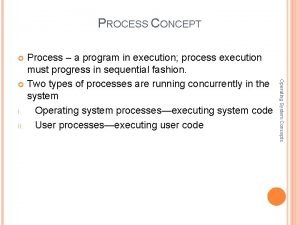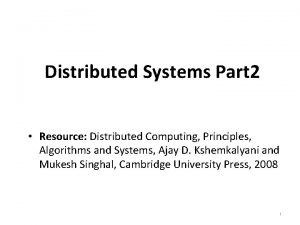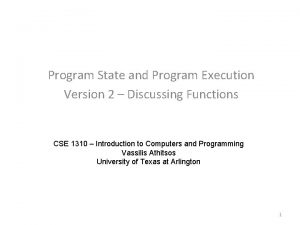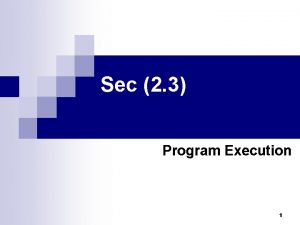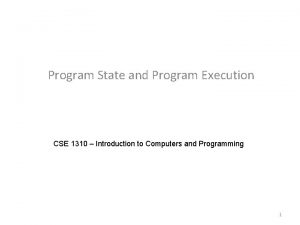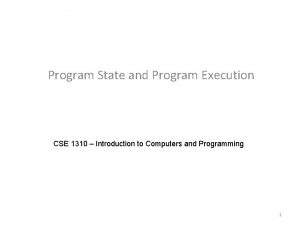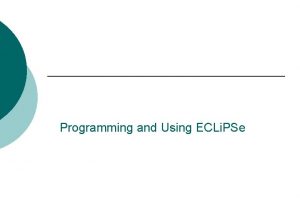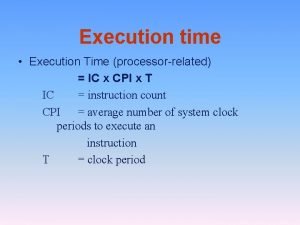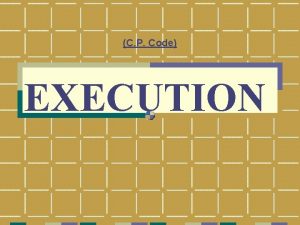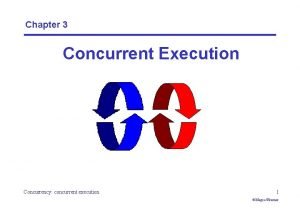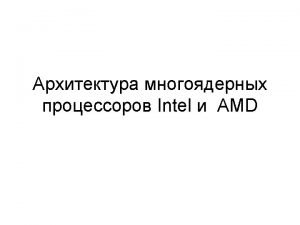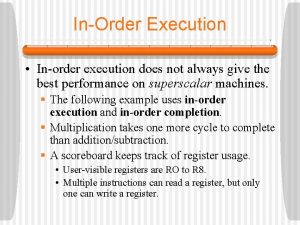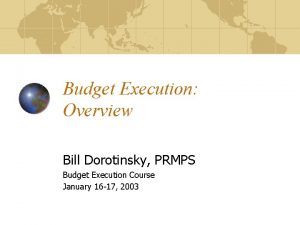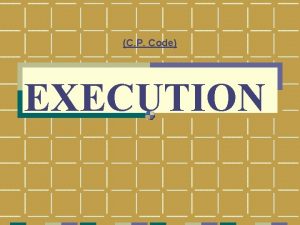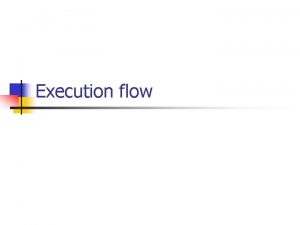Program State and Program Execution Version 2 Discussing

































- Slides: 33

Program State and Program Execution Version 2 – Discussing Functions CSE 1310 – Introduction to Computers and Programming Vassilis Athitsos University of Texas at Arlington 1

Program State vs. Program History • The state of the program contains all the information that we need to determine what the program will do next. • The state of the program is typically much more simple than the history of the program, which describes everything than the program did from the beginning till now. • The computer always keeps track of program state. • As a rule (with rare exceptions) the computer does NOT keep track of program history. 2

Understanding Program States • Understanding any piece of code (whether it is an if statement, while loop, function call) means understanding how that piece of code changes program state. – Code that does not change the program state is useless. • Conversely, if you do not understand precisely how some piece of code changes program state, you do not understand that piece of code. 3

Defining a Program State • A program state consists of: – Namespaces, that associate variable names with values. • Only one namespace is visible at each moment in the program execution, but multiple other namespaces may still be in memory, and can become visible later. – A calling stack, which describes what line(s) of code we are currently executing. 4

The Calling Stack • The calling stack describes what line(s) of code we are executing right now. The calling stack contains a sequence of program lines: – – The current line L_1 we are executing. The line L_2 that made the last function call. The line L_3 that made the second-to-last function call. And so on, until some line L_N that belongs to the main code. • Important: for every line in the calling stack, additional information is needed: – Exactly which function call is being evaluated (lines of code may include multiple function calls). – Which subexpressions have already been evaluated and what values they returned. 5

The Calling Stack • The calling stack describes what line(s) of code we are executing right now. The calling stack contains a sequence of program lines: – – The current line L_1 we are executing. The line L_2 that made the last function call. The line L_3 that made the second-to-last function call. And so on, until some line L_N that belongs to the main code. • Important: for every line in the calling stack, additional information is needed: – Exactly which function call is being evaluated (lines of code may include multiple function calls). – Which subexpressions have already been evaluated and what values they returned. WE WILL GET BACK TO THIS TOPIC, IT IS IMPORTANT. 6

Correspondences between Namespaces and Calling Stack • At any point in the program, the number of namespaces is equal to the number of lines in the calling stack. • Each line in the calling stack corresponds to a different namespace. – Why? Because each line in the calling stack corresponds to a different function call. 7

The Order of Evaluating Subexpressions • For every line in the calling stack, we process it by evaluating its subexpressions, and using the resulting values. • In what order do we evaluate subexpressions? – Evaluate simpler expressions before larger expressions that contain the simple ones. • Does this specify a complete order? NO • The order in which subexpressions are evaluated may matter (in bad code), but should never matter in good code. 8

An Example of Program Execution def cube(n): result = n*n*n return result # start of main code x=3 result = cube(x) + cube(x+1) print("result =", result) 9

An Example – Numbering Lines To make it easy to refer to lines of code, we assign numbers to each line Line 1: def cube(n): Line 2: result = n*n*n Line 3: return result # start of main code Line 4: x = 3 Line 5: result = cube(x) + cube(x+1) Line 6: print("result =", result) 10

Program Execution Where do we start from? How do we initialize the program state? Line 1: def cube(n): Line 2: result = n*n*n Line 3: return result # start of main code Line 4: x = 3 Line 5: result = cube(x) + cube(x+1) Line 6: print("result =", result) 11

Program Execution Calling Stack: Initializing main Main Namespace: Line 1: def cube(n): Line 2: result = n*n*n Line 3: return result # start of main code Line 4: x = 3 Line 5: result = cube(x) + cube(x+1) Line 6: print("result =", result) 12

Program Execution Calling Stack: Line 4 Line 1: def cube(n): Line 2: result = n*n*n Line 3: return result # start of main code Line 4: x = 3 Line 5: result = cube(x) + cube(x+1) Line 6: print("result =", result) Main Namespace: x=3 13

Program Execution Calling Stack: Line 5: result = cube(x) + cube(x+1) Line 1: def cube(n): Line 2: result = n*n*n Line 3: return result # start of main code Line 4: x = 3 Line 5: result = cube(x) + cube(x+1) Line 6: print("result =", result) Main Namespace: x=3 14

Program Execution Calling Stack: Line 5: result = cube(x) + cube(x+1) Line 1: def cube(n): Line 2: result = n*n*n Line 3: return result # start of main code Line 4: x = 3 Line 5: result = cube(x) + cube(x+1) Line 6: print("result =", result) Main Namespace: x=3 Note: it is not sufficient to just show Line 8 in the calling stack. We need to specify which subexpression we will work on. Which subexpression should we choose? 15

Program Execution Calling Stack: Line 5: result = cube(x) + cube(x+1) Line 1: def cube(n): Line 2: result = n*n*n Line 3: return result # start of main code Line 4: x = 3 Line 5: result = cube(x) + cube(x+1) Line 6: print("result =", result) Main Namespace: x=3 Note: it is not sufficient to just show Line 8 in the calling stack. We need to specify which subexpression we will work on. Which subexpression should we choose? As long as the code follows good guidelines, the order does not matter. 16

Program Execution Calling Stack: Line 5: result = cube(x) + cube(x+1) Line 1: def cube(n): Line 2: result = n*n*n Line 3: return result # start of main code Line 4: x = 3 Line 5: result = cube(x) + cube(x+1) Line 6: print("result =", result) Main Namespace: x=3 17

Program Execution cube Namespace: Calling Stack: n=3 Line 1: def cube(n): Line 5: result = cube(x) + cube(x+1) Main Namespace: Line 1: def cube(n): Line 2: result = n*n*n Line 3: return result # start of main code Line 4: x = 3 Line 5: result = cube(x) + cube(x+1) Line 6: print("result =", result) x=3 18

Program Execution cube Namespace: Calling Stack: n=3 result = 27 Line 2: result = n*n*n Line 5: result = cube(x) + cube(x+1) Main Namespace: Line 1: def cube(n): Line 2: result = n*n*n Line 3: return result # start of main code Line 4: x = 3 Line 5: result = cube(x) + cube(x+1) Line 6: print("result =", result) x=3 19

Program Execution cube Namespace: Calling Stack: n=3 result = 27 Line 3: return result Line 5: result = cube(x) + cube(x+1) Main Namespace: Line 1: def cube(n): Line 2: result = n*n*n Line 3: return result # start of main code Line 4: x = 3 Line 5: result = cube(x) + cube(x+1) Line 6: print("result =", result) x=3 20

Program Execution Calling Stack: Line 5: result = 27 + cube(x+1) Line 1: def cube(n): Line 2: result = n*n*n Line 3: return result # start of main code Line 4: x = 3 Line 5: result = cube(x) + cube(x+1) Line 6: print("result =", result) Main Namespace: x=3 Note: - the namespace for cube disappears. - in the calling stack, the returned value replaces the function call in the calling line. 21

Program Execution Calling Stack: Line 5: result = 27 + cube(x+1) Line 1: def cube(n): Line 2: result = n*n*n Line 3: return result # start of main code Line 4: x = 3 Line 5: result = cube(x) + cube(x+1) Line 6: print("result =", result) Main Namespace: x=3 Next subexpression to evaluate in current line: x+1 22

Program Execution Calling Stack: Line 5: result = 27 + cube(4) Line 1: def cube(n): Line 2: result = n*n*n Line 3: return result # start of main code Line 4: x = 3 Line 5: result = cube(x) + cube(x+1) Line 6: print("result =", result) Main Namespace: x=3 23

Program Execution Calling Stack: Line 5: result = 27 + cube(4) Line 1: def cube(n): Line 2: result = n*n*n Line 3: return result # start of main code Line 4: x = 3 Line 5: result = cube(x) + cube(x+1) Line 6: print("result =", result) Main Namespace: x=3 Next subexpression to evaluate in current line: cube(4) 24

Program Execution cube Namespace: Calling Stack: n=4 Line 1: def cube(n): Line 5: result = 27 + cube(4) Main Namespace: Line 1: def cube(n): Line 2: result = n*n*n Line 3: return result # start of main code Line 4: x = 3 Line 5: result = cube(x) + cube(x+1) Line 6: print("result =", result) x=3 25

Program Execution cube Namespace: Calling Stack: n=4 result = 64 Line 2: result = n*n*n Line 5: result = 27 + cube(4) Main Namespace: Line 1: def cube(n): Line 2: result = n*n*n Line 3: return result # start of main code Line 4: x = 3 Line 5: result = cube(x) + cube(x+1) Line 6: print("result =", result) x=3 26

Program Execution cube Namespace: Calling Stack: n=4 result = 64 Line 3: return result Line 5: result = 27 + cube(4) Main Namespace: Line 1: def cube(n): Line 2: result = n*n*n Line 3: return result # start of main code Line 4: x = 3 Line 5: result = cube(x) + cube(x+1) Line 6: print("result =", result) x=3 27

Program Execution Calling Stack: Line 5: result = 27 + 64 Line 1: def cube(n): Line 2: result = n*n*n Line 3: return result # start of main code Line 4: x = 3 Line 5: result = cube(x) + cube(x+1) Line 6: print("result =", result) Main Namespace: x=3 Note: in the calling stack, the returned value replaces the function call in the calling line. 28

Program Execution Calling Stack: Line 5: result = 27 + 64 Line 1: def cube(n): Line 2: result = n*n*n Line 3: return result # start of main code Line 4: x = 3 Line 5: result = cube(x) + cube(x+1) Line 6: print("result =", result) Main Namespace: x=3 Next subexpression to evaluate in current line: 27 + 64 29

Program Execution Calling Stack: Line 5: result = 91 Line 1: def cube(n): Line 2: result = n*n*n Line 3: return result # start of main code Line 4: x = 3 Line 5: result = cube(x) + cube(x+1) Line 6: print("result =", result) Main Namespace: x=3 30

Program Execution Calling Stack: Line 5: result = 91 Line 1: def cube(n): Line 2: result = n*n*n Line 3: return result # start of main code Line 4: x = 3 Line 5: result = cube(x) + cube(x+1) Line 6: print("result =", result) Main Namespace: x=3 Next to be done in Line 5: use computed value(s) as prescribed by that line (i. e. , do an assignment). 31

Program Execution Calling Stack: Line 5: result = 91 Line 1: def cube(n): Line 2: result = n*n*n Line 3: return result # start of main code Line 4: x = 3 Line 5: result = cube(x) + cube(x+1) Line 6: print("result =", result) Main Namespace: x=3 result = 91 Next to be done in Line 5: use computed value(s) as prescribed by that line (i. e. , do an assignment). 32

Program Execution Calling Stack: Line 6: print("result =", result) Line 1: def cube(n): Line 2: result = n*n*n Line 3: return result # start of main code Line 4: x = 3 Line 5: result = cube(x) + cube(x+1) Line 6: print("result =", result) Main Namespace: x=3 result = 91 33
 Advantage and disadvantage writing
Advantage and disadvantage writing Discussing advantages and disadvantages
Discussing advantages and disadvantages Two technicians are discussing oil and filter changes
Two technicians are discussing oil and filter changes When discussing comparative and absolute advantage
When discussing comparative and absolute advantage Btechsmartclass in c
Btechsmartclass in c A process is a program in execution
A process is a program in execution Sim instruction in 8085
Sim instruction in 8085 Two technicians are discussing clogged egr passages
Two technicians are discussing clogged egr passages An ignition coil operates using the principle of
An ignition coil operates using the principle of An ignition coil operates using the principle of
An ignition coil operates using the principle of Where is connector c250 located?
Where is connector c250 located? Two technicians are discussing schematic symbols
Two technicians are discussing schematic symbols Two technicians are discussing tire rotation
Two technicians are discussing tire rotation Politicians discussing global warming sculpture
Politicians discussing global warming sculpture Two technicians are discussing torque wrenches
Two technicians are discussing torque wrenches Two technicians are discussing a stepped ect circuit
Two technicians are discussing a stepped ect circuit 111 project
111 project Gulf of evaluation
Gulf of evaluation Mutual exclusion in distributed system tutorialspoint
Mutual exclusion in distributed system tutorialspoint Process and execution
Process and execution Project management chapter 4
Project management chapter 4 Planning programming budgeting and execution ppbe process
Planning programming budgeting and execution ppbe process Phases of shooting a basketball
Phases of shooting a basketball Siklus interaksi
Siklus interaksi A mob's illegal seizure and execution of a person.
A mob's illegal seizure and execution of a person. A mob's illegal seizure and execution of a person.
A mob's illegal seizure and execution of a person. A mob's illegal seizure and execution of a person.
A mob's illegal seizure and execution of a person. Gulf of execution and evaluation
Gulf of execution and evaluation Language processor mcq
Language processor mcq State testing and testability tips
State testing and testability tips Absorptive state vs postabsorptive state
Absorptive state vs postabsorptive state Synthesis of glycogen
Synthesis of glycogen State state graphs and transition testing
State state graphs and transition testing Two households both alike in dignity
Two households both alike in dignity





